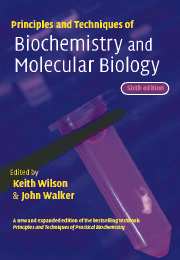Book contents
- Frontmatter
- Contents
- Preface to the sixth edition
- List of contributors
- List of abbreviations
- 1 Basic principles
- 2 Cell culture techniques
- 3 Centrifugation
- 4 Microscopy
- 5 Molecular biology, bioinformatics and basic techniques
- 6 Recombinant DNA and genetic analysis
- 7 Immunochemical techniques
- 8 Protein structure, purification, characterisation and function analysis
- 9 Mass spectrometric techniques
- 10 Electrophoretic techniques
- 11 Chromatographic techniques
- 12 Spectroscopic techniques: I Atomic and molecular electronic spectroscopy
- 13 Spectroscopic techniques: II Vibrational spectroscopy and electron and nuclear spin orientation in magnetic fields
- 14 Radioisotope techniques
- 15 Enzymes
- 16 Cell membrane receptors
- Index
- Plate sections
13 - Spectroscopic techniques: II Vibrational spectroscopy and electron and nuclear spin orientation in magnetic fields
Published online by Cambridge University Press: 05 June 2012
- Frontmatter
- Contents
- Preface to the sixth edition
- List of contributors
- List of abbreviations
- 1 Basic principles
- 2 Cell culture techniques
- 3 Centrifugation
- 4 Microscopy
- 5 Molecular biology, bioinformatics and basic techniques
- 6 Recombinant DNA and genetic analysis
- 7 Immunochemical techniques
- 8 Protein structure, purification, characterisation and function analysis
- 9 Mass spectrometric techniques
- 10 Electrophoretic techniques
- 11 Chromatographic techniques
- 12 Spectroscopic techniques: I Atomic and molecular electronic spectroscopy
- 13 Spectroscopic techniques: II Vibrational spectroscopy and electron and nuclear spin orientation in magnetic fields
- 14 Radioisotope techniques
- 15 Enzymes
- 16 Cell membrane receptors
- Index
- Plate sections
Summary
INTRODUCTION
In Chapter 12 it was established that the electromagnetic spectrum was a continuum of frequencies from the high energy γ-rays of nuclear origin to the long wavelength region of the radiofrequencies. The energy associated with the spectrum decreases as it is traversed from the high to low frequency regions, according to the rules of quantum theory. There is therefore no obvious logical dividing point where this overall spectrum may be split. The split presented in this text is one of convenience. The justification is purely pragmatic and is based on ‘common practice’. The biologist or biomedical scientist, having isolated a ‘new’ material (compound), is faced, initially, with the requirement to identify this isolate. Amongst the spectroscopic and spectrometric techniques available, assuming sufficient pure material has been obtained, the first analytical procedures to be used would, in practice, involve the methods described in this chapter. There are two important reasons for this approach: first, a considerable amount of information is obtained from a ‘single’ analysis and, secondly, the techniques are non-destructive. In view of the latter reason, replicate analyses may be performed in many cases, to improve signal-to-noise ratios, and precious samples can be recovered that may then be subjected to other analytical investigations.
In Chapter 9 the mass spectrometric techniques are encountered. These techniques give information different from and complementary to the spectroscopic ones.
- Type
- Chapter
- Information
- Principles and Techniques of Biochemistry and Molecular Biology , pp. 593 - 620Publisher: Cambridge University PressPrint publication year: 2005



